NoirDynosaur
Yurrrrrrrrrr
What's going on everyone. it's your homie Noir back with another historical banger.
It's common knowledge by now that Cristobal Columbus did not discover America. Let's chop it up.
Source: Did West Africans live in Four Corners Region of the United States from 12th Century? Shout out to Dr. Clyde Winters (one of the greatest scholars in Black African diaspora)
Disclaimer: The Kalifornians/Mojave, Wachitaw, Yamasee and Dariens (Panama) groups are also part of the Mende people.
More evidence
Source: Ancient Black History: Olmec, Mayan, Xi People, Writing, Otomi, Mande & Yoruba
There were 4 migrations of Black Africans.
1) The Twa pygmies - Brazil
2) The Sudanese Nubians - Central America/Caribbeans "Caribs". Also called Garifunas
3.) Mande/Mende - Central America, Brazil and North America
4.) Trans Atlantic - North America, South America, Caribbean and Central America
Everyday is black history. Remember your ancestors. Y'all enjoy
It's common knowledge by now that Cristobal Columbus did not discover America. Let's chop it up.
Around A.D. 1310, thousands of West Africans arrived in the Americas from ancient Mali. Ibn Fadlullah al- Umari, in his encyclopedia "Masalik al Absar", said that mariners from Mali during the reign of Abubakari made transatlantic voyages. Al-Umari, obtained his information from Mansa Musa,
who was handed the kingship of Mali by Abubakari when he set out to colonize the Americas.
Mansa Musa, said that Mansa Abubakari would not believe that it was impossible to discover the limits of the neighboring sea (the Atlantic). Musa, told al-Umari: "so he sent out 200 ships equipped and filled with men and the same number filled with gold, water and enough food to last them for years. Muhammad Abubakari, commanded that the captain not return until the supplies were exhausted".
After sometime, according to Mansa Musa, a single ship returned and the captain was ordered to report his findings. "Prince", he replied "we sailed for a long time up to the moment when we encountered in mid-Ocean something like a river with a violent current. My ship was last. The others sailed on...they disappeared and did not come back".
"But the Emperor [Abubakari] did not believe him", continued Musa, "He equipped two thousand vessels, a thousand for himself, and a thousand for water and supplies. He conferred power on me [Mansa Musa] and left with his companions on the ocean".
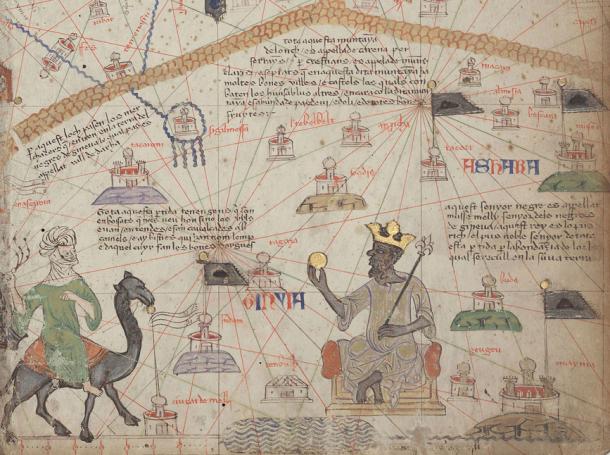
Mansa Musa depicted holding a gold nugget, from the 1375 Catalan Atlas ( public domain )
The expeditionary force of Mansa Abubakari, must have been immense, because the average boat on the Niger, in the 1500's A.D., could carry 80 men. This means that anywhere between 25,000 to 80,000 men may have sailed from Mali along with Mansa Abubakari.
The mention of a violent current in mid-ocean by Abubakari's captain may refer to the Atlantic Ocean currents, which can carry a boat from Africa to the Americas.
We can hypothesize that Abubakari and his expeditionary force probably left the city of Niani, by canoe and traveled down the Niger to the Gulf of Guinea. From here the expeditionary force was probably carried by the Guinea Current out into the Atlantic where it met the South Equatorial Current. The South Equatorial Current carried the Mali explorers to South America.
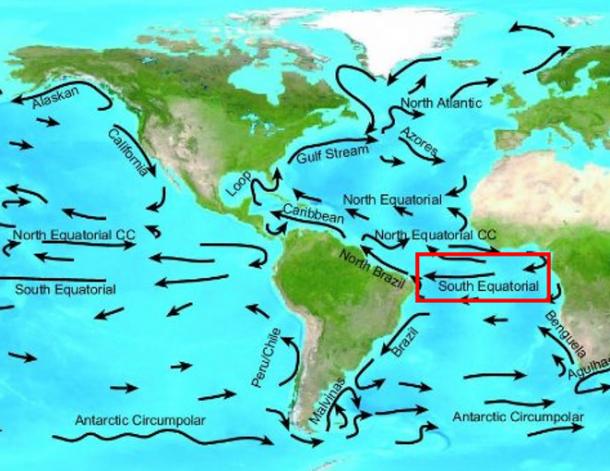
The South Equatorial Current probably took Abubakari’s expedition across the Atlantic to Brazil ( public domain )
Abubakari's ships would not be the last vessels to be carried to Brazil. For example, in 1500, Alvares Cabral's ship was captured by the North Equatorial Current and swiftly taken to Brazil.
There were many African communities found by the Spanish in the Southern part of the United States and Florida (1-2). Arnaiz-Villena et al (3) and other researchers have suggested that Sub-Saharan Africans (SSA) were among the first Americans (4-8). Spanish explorers found Sub-Saharan Africans already in Mexico when they arrived (3-4). In addition, to reports of the First Spanish Chronicles eyewitness accounts of SSA populations in the Caribbean, and Mexico anthropologists have found SSA skeletons at Pre-Columbian sites (8-15). Some of the ancient Maya may have been SSA, because ancient Mayan skeletal remains indicate that they suffered from sickle cell anemia (11).
Quatrefages speaks of black men who penetrated to the American southwest while other Africans migrated into Southern California (2). And as late as 1775, Father Francisco Garces discovered a race of Black men, clearly African, residing in a community beside the Zuni Indians in New Mexico. According to Quatrefages the two races spoke different languages.
In 1528, the Spanish explorer Cabeza de Vaca and Estevanico the Moor (Blackman) from Azamor discovered numerous people living in the American Southwest as they sought to discover the Seven Cities of Cibola. The Seven Cities of Cibola were supposed to be centers where fantastic amounts of gold could be found.
In what is now known as Four Corners region where the states of Utah, Colorado, New Mexico and Arizona come together at a common point the Anasazi tilled the earth and even irrigated their crops, and stored some of the harvest for later use.
The presence of Manding (language of West Africa) in the Four Corners, is supported by the appearance of Dogon and Bambara ideograms, called petroglyphs, on rocks in the Anasazi area. Moreover, there are several tablets found in Four Corners which have been deciphered that were written in an aspect of Malinke-Bambara, the language spoken by the King of Mali and his royal court.
In the Four Corners region de Vaca, found various ethnic groups speaking a multiplicity of languages. Due to the pluralistic nature of these societies the people could only communicate using sign language. Ceram noted that: “In reality the inhabitants of the pueblos, as we now know, were members of extraordinarily varied tribes. They spoke widely different languages and had different historical backgrounds” (16).
De Vaca said that one of these ethnic groups was named Mendica (17). This name is almost identical to the word Mandinka (Malinke), the name of one of the Mande speaking people that ruled in the vast Mali Empire of West Africa.
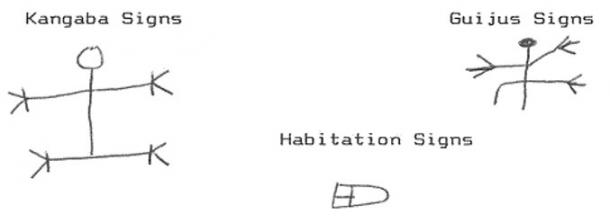
The Mande people left many inscriptions and habitation signs in the Four Corners areas, seen in the picture above. In the Anasazi area we find many depictions of the Malinke- Bambara habitation sign and Kangaba sign in the American southwest. This sign is frequently found in West Africa, in areas settled by the Mande speaking people. The Kangaba sign, is clearly depicted among the glyphs found in the Guijus range of southern Arizona.
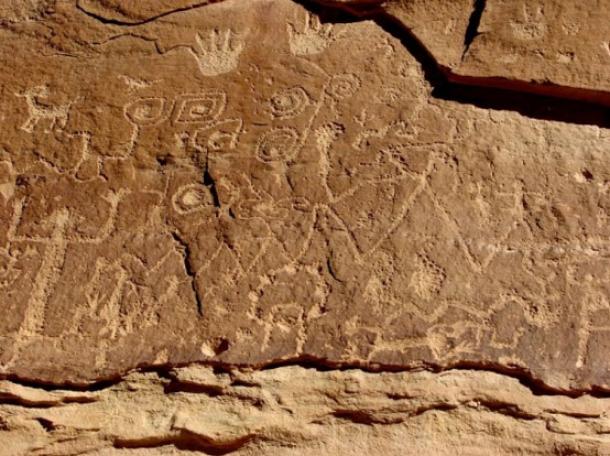
Southwest Petroglyph
The ruins of the Anasazi stone cities are crouched low on the Mesa tops or nestled in caves along the sheer canyon walls of this high desert region. These stone cities are the exact replica of stone cliff dwellings found in West African areas that formerly formed part of the Mali Empire, especially the Dogon towns.
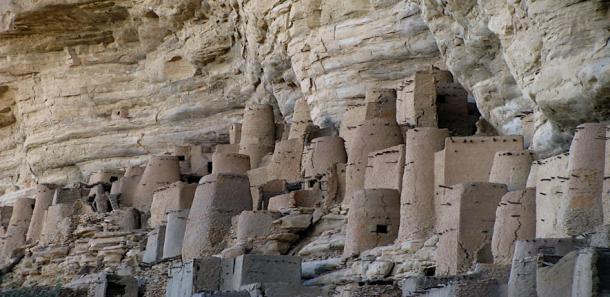
Dogon Cliff Dwellings in Africa
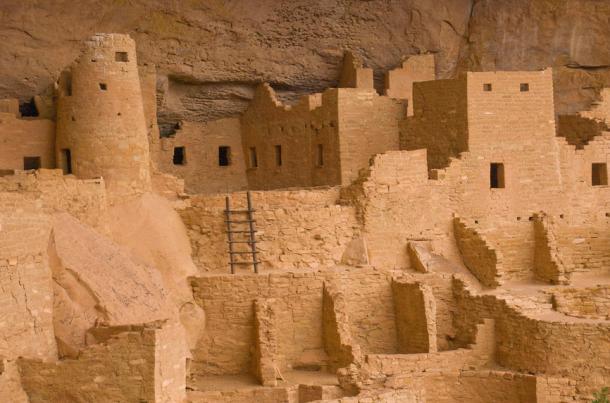
Anasazi Cliff Dwellings in Colorado ( Ron Cogswell / Flickr )
Due to the spread of nomadic Amerindians from the northwest, the Anasazi were forced from their stone cities and cliff dwellings by the invaders. There was probably some intermarriages between Africans and Amerindians and today we see a negroid strain among the southwestern Amerindian populations (17). In addition, many African communities were found in the Southwest when Europeans arrived in this part of the United States.
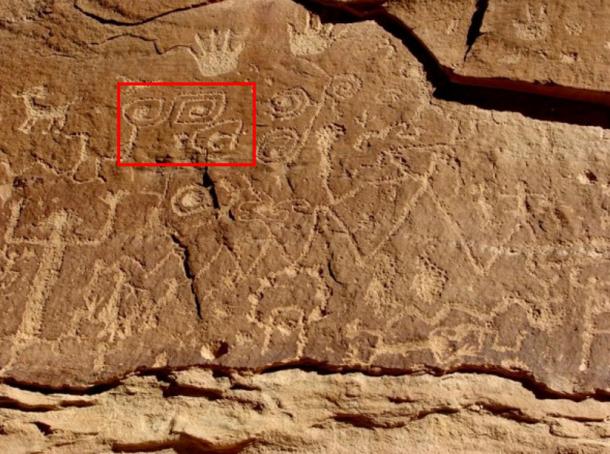
Mesa Verde Mande Habitation Sign
A major Malian inscription in the Four Corners Region is found at Palatki. The Palatki ruins are found in Sedona, Arizona. Here we see cliff dwellings and inscriptions.
Palatki is one of the largest cliff dwellings situated in the Sedona area. The Palatki site has been dated between 1100-1300 AD. This would place habitation of the site around the time the Mendica or Mandinka expedition led by Abubakari had arrived in the New World.
Jack Andrews believes that the inscriptions are written in Sanskrit (19). The Inscription from Palatki inscriptions are not written in Sanskrit, they were written in the Malinke-Bambara language of the Malians. This inscription was found near the ruins of the Palatki cliff dwellings.

Palatki Cliff Dwellings
The Palatki cliff dwellings are similar to the Tellem Cliff Houses in Africa.
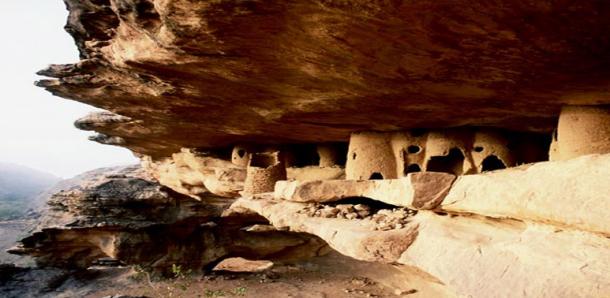
Malian Cliff Dwellings from Tellem
The Pilatki inscriptions is also written in Manding not Sanskrit. Below we see the following signs.

The Malinke inscriptions are read from right to left. Top to bottom. There are five Malinke or Mande signs on the Palatki inscriptions. The inscription says:
Be
su i se
Se Gyo/Jo
The English translation is as follows: “Exist here a superior place of habitation. Make (this) place
a success, consecrated to the Divinity”
In summary, de Vaca tells us that there were mongoloid and Negro (Black) tribes in the Four Corners. One of these tribes was named Mendica. Mendica is the same as Mandinka, the name for the people who ruled and founded the Mali Empire.
The presence of the Mendica tribe in the Four Corners, along with the archaeological and historical evidence from Africa and the Americas, coupled with the decipherment of ancient Mande scripts and habitation markers (signs) used in the New World; illustrates that people from Mali, probably led by Mansa Abubakari, colonized many parts of the Americas during the first quarter of the 14th Century A.D, including the Four Corners Region.
The presence of Malians in Four Corners, is supported by the appearance of Dogon and Bambara ideograms, called petroglyphs, and habitation signs on rocks in the Anasazi area, and analogous cliff dwellings.
In conclusion, in 1310 AD thousands of Malians arrived in the Americas. Many of these Malians settled throughout South America and the American Southwest where they left numerous inscriptions written in the Malinke Bambara language that was spoken by the Malian court.
The Palatki inscription is written in the Mande language not Sanskrit. These inscriptions, like those recorded by WILLIAM JAMES VEALL in Sea-Farers from the Levant: Do Ancient Inscriptions Rewrite History of the Americas? - Part 2, describe the picturesque setting where the Palatki inscription and cave dwellings are found.
Due to the spread of nomadic Amerindians from the northwest, the Anasazi were forced from their stone cities and cliff dwellings by the invaders. The report of de Vaca, makes it clear that many Malians or Mendica were still in Four Corners when the Spanish made their way to the region. There was probably some intermarriage between Africans and Amerindians, which would explain the negroid strain we see among some of the southwestern Amerindian populations.
Source: Did West Africans live in Four Corners Region of the United States from 12th Century? Shout out to Dr. Clyde Winters (one of the greatest scholars in Black African diaspora)
Disclaimer: The Kalifornians/Mojave, Wachitaw, Yamasee and Dariens (Panama) groups are also part of the Mende people.
More evidence
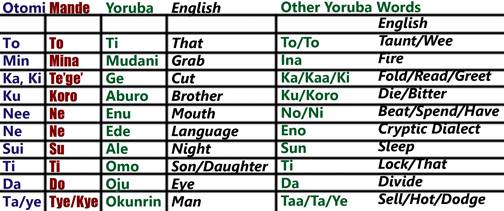
The major evidence of the African origins of the Olmecs comes from their writing. The writing system used by the Olmec and later adopted by the Maya, was first used by Mande speaking people in North/West Africa and is called Libyco-Berber ( even-though it can not be read in Taureg).

The first scholar to recognise the african origin of the Olmec writing was Leo Wiener, in Dr. Wiener, highlighted the fact that the writing on the Tuxtla statuette was identical to writing used by the Mande speaking people.
In addition to the Mande speaking Olmec or Xi people influencing the Mayan languages they also influenced the Otomi language of Mexico. The Otomi language also shows affinity to the Mande languages.
Haslip-Viera, Ortiz de Montellano and Barbour (1997) have argued that Olmec civilisation was not influenced by Africans and therefore Afrocentrism should have no standing in higher education, but in fact it can be illustrated that the facial types associated with the Olmec people and Meroitic people are identical;
And that Olmec figurines such as the Tuxtla statuette excavation are inscribed with African writing used by the Mande people of West Africa. (Wiener, 1922; Winters, 1979 , of Manding writing provide the "absolute proof " recovered by archaeologists from "controlled excavations in the New World" demanded by Haslip-Viera, Ortiz de Montellano and Barbour (1997: 419) to "proof"/confirm Olmec and African contact.
Source: Ancient Black History: Olmec, Mayan, Xi People, Writing, Otomi, Mande & Yoruba
There were 4 migrations of Black Africans.
1) The Twa pygmies - Brazil
2) The Sudanese Nubians - Central America/Caribbeans "Caribs". Also called Garifunas
3.) Mande/Mende - Central America, Brazil and North America
4.) Trans Atlantic - North America, South America, Caribbean and Central America
Everyday is black history. Remember your ancestors. Y'all enjoy




 right?
right?

 You mean evidence like a magical book
You mean evidence like a magical book